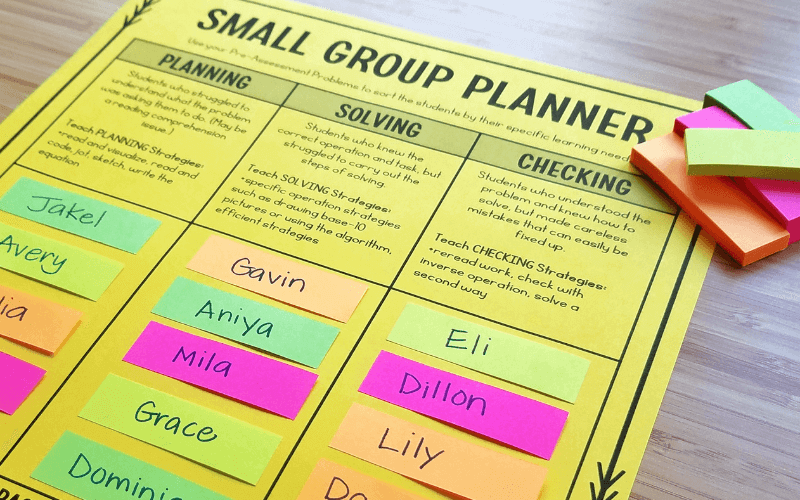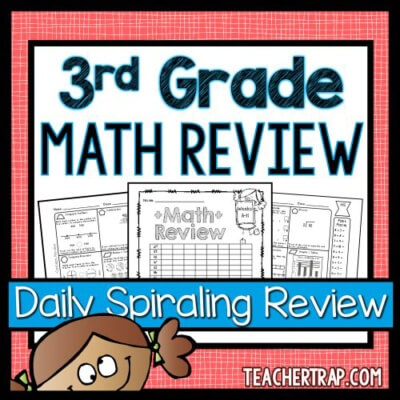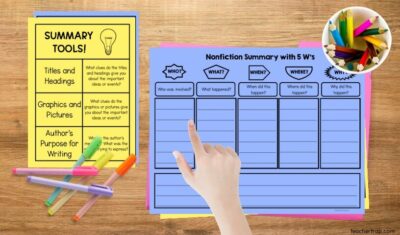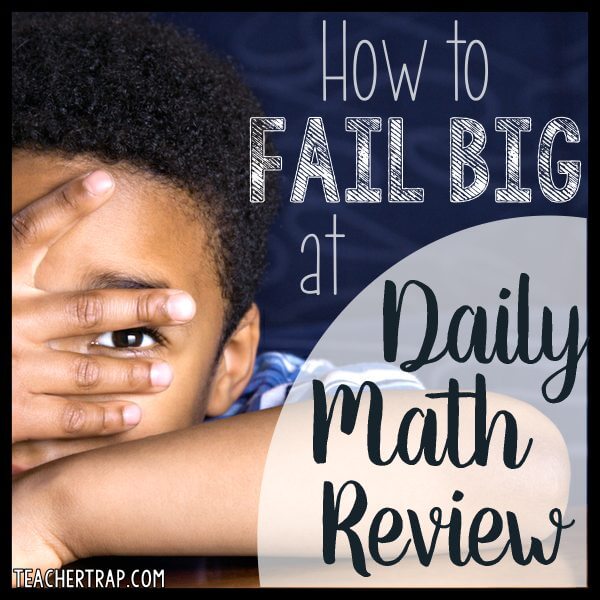
So you want to FAIL BIG at Daily Math Review? I can help! I know from personal experience some tried and true ways to make daily math review tedious, ineffective, and time-consuming. Luckily, I’ve included some ideas that will allow YOU to learn from MY mistakes! 🙂
FAIL BIG Strategy #1: Practice different skills every single day.
Problem: Practicing different skills every single day denies students the chance to build on previous learning.
Think about it… A lot of those daily math review resources spiral through skills quickly, reviewing new concepts each day. Let’s say on Monday, students do a perimeter problem. The ones who already know how to do it are reminded that they know how to do it. The ones that don’t know how to do it find out the opposite. And maybe they hear how to do it properly. But the next day you’re on to other skills so there’s no chance for those kids to try again and practice the right way! If you spiral too quickly (daily), all you do is reinforce what kids already know and do, be it right or wrong.
Solution: Spiral through skills weekly rather than daily.
This one is so easy to fix! Just make sure you stick with a set of skills for at least a week at a time. You might choose 3 – 5 focus skills each week. Now you can review, reteach as needed, and allow students time to PRACTICE their newly refined learning.
If you’re spiraling weekly, you should be able to bring up the same concepts again each month, giving students the ongoing refreshers they need.
FAIL BIG Strategy #2: Don’t go over the work (ever).
Problem: When you don’t go over the math review work, you’re reinforcing bad habits and misconceptions.
We’re all pressed for time and I know that for many years I included a daily math review as morning work. The students did the work and put it away and that was it. At the end of the week, I’d double-check that the work was complete and maybe spot-check a few problems. I felt good because the kids were practicing all their math skills. Unfortunately, many of them were practicing bad habits and reinforcing misconceptions. For example, one student was confused about borrowing in the subtraction algorithm. Each week, he did the review problems the same way, practicing the WRONG process, never realizing it. If I’d made a point to teach him the correct way sooner, he could have been practicing the RIGHT process all that time! Oops.
Solution: Include time for going over the work!
I know it’s hard, but it’s so worth it! I like having students do the math review as morning work but then go over it later in the day. This gives me a little more flexibility in finding a chunk of time for the discussion.
Another possibility is changing it up throughout the week. For example, on Monday you might spend 15 minutes really going over the skills and work. On Tuesday, you might give students 5 minutes to check their work with a partner. On Wednesday, you could spend 10 minutes spot-checking a few problems but then discuss others in detail. On Thursday, you might only have 5 minutes so you simply show some student work samples. Then on Friday, you could spend the full 15 minutes once more. Be creative with your time!

FAIL BIG Strategy #3: Focus only on correct answers.
Problem: The purpose of daily math review is to keep skills fresh AND to reinforce effective strategies. If you’re only focusing on correct answers, you miss the most powerful part!
It’s great to spend time “checking” work, but “checking” work is very different than “discussing” work. When you check work, you typically have students look for the correct answer. This allows students to see how they’re doing, but doesn’t help them IMPROVE.
Math review is about noticing what is going well and making small changes to improve what isn’t.
Solution: Focus on strategies.
When going over the math review work, have students notice their STRATEGIES, not just their answers. We all teach strategies, such as underlining important words, labeling coins, or making “flower clocks” to tell time. Whatever strategies you teach, reinforce them during math review. When we go over our work now, students give themselves stars for their good strategies. “Give yourself a star if you underlined the word estimate.” “Give yourself a star if you labeled the value of each coin.”
This practice has helped students focus on what they are doing RIGHT, as well as helped to reinforce the use of all those strategies I teach. It’s not just about the final answer, it’s about the process.
FAIL BIG Strategy #4: Just focus on skills (not problem-solving or mental math or math fluency…)
Problem: There’s more to math than the tested skills. If you aren’t providing your students with daily practice in problem-solving, mental math, and math fluency, you’re missing a big part of growing those little mathematicians.
With all the pressure of testing, it’s hard to remember that math is about more than a test score. I know there were years when I drilled CONCEPTS all year. We practiced perimeter, telling time, counting coins, measuring with a ruler, and other SKILLS over and over. Unfortunately, this left little room for developing deeper problem-solving strategies, flexible thinking, or fluency.
Solution: To grow strong mathematicians we need to provide a balance of skill practice, problem-solving, and fluency work. Make sure you include time for more complex problem-solving, such as a problem-of-the-day or “mind bender” that allows students to apply multiple skills in a new context. Build in some mental math practice, too. It can be quick and can happen any time (like while waiting in line before lunch). “How many sides on a square? Double that. Add 10. Add 100. What’s the number?” And don’t forget fluency practice. I know that for a time, teachers were shying away from practicing math facts, instead focusing on developing number sense and strategies. Although those things are important, so is fluency! No one wants to stand there counting by 5’s to solve 9 x 5. We want and need those kind of answers to be automatic and quick! I like to send sets of math facts as homework and then do quick review and practice at school.
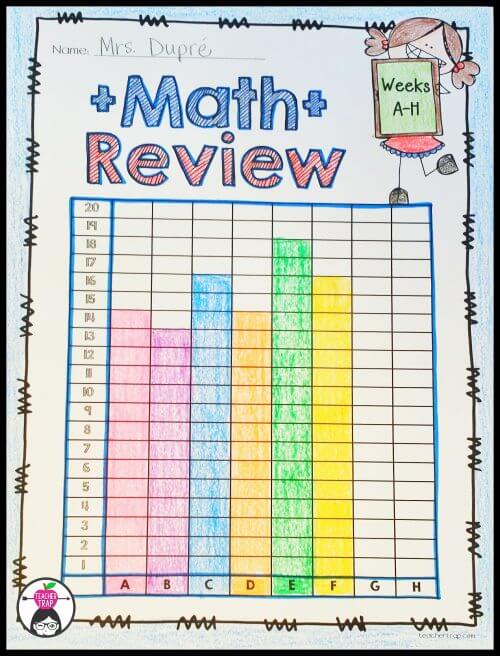
FAIL BIG Strategy #5: Grade it.
Problem: Grading math review makes it more about getting the right answers than practicing the right strategies.
Grades are meant to assess final outcomes of learning, not to judge the learning process. Math review is meant to be an ongoing review and refinement of learning. When I did choose to grade students’ math review work, I saw that the students who were struggling began to feel stressed. Those students became more frustrated (or started cheating to get right answers) and the feel of math review changed for the worse.
Solution: Help students set personal goals and track progress.
Rather than taking a grade on their math review work, I recommend helping students set goals and track their own progress. We do this by keeping track of the “stars” students earn. As we go over the work each day, students earn stars for both good strategies and correct answers. They tally up their total number of stars and write the number on the top corner of their page. Throughout the week, students can track their own improvement! I like to provide a simple graph page (above) where students record their stars from one day each week (typically Friday). This allows students to see their progress over the months, as well.
Because I couldn’t find a daily math review system that included all these components, I ended up making one for my own students. In this 3rd Grade Math Review Pack, I’ve incorporated all the best practices mentioned in this post and included all the major 3rd grade math skills and concepts. Sorry, but I’ve only got it for third grade!! I appreciate the requests for a second grade version, but this was A LOT of work and it will take me awhile to finish another set…
Either way, you can peek at it to get a feel for the routine I use and find some printable explanations and guidelines in the PREVIEW.
What have you found to be most powerful in your math review?







